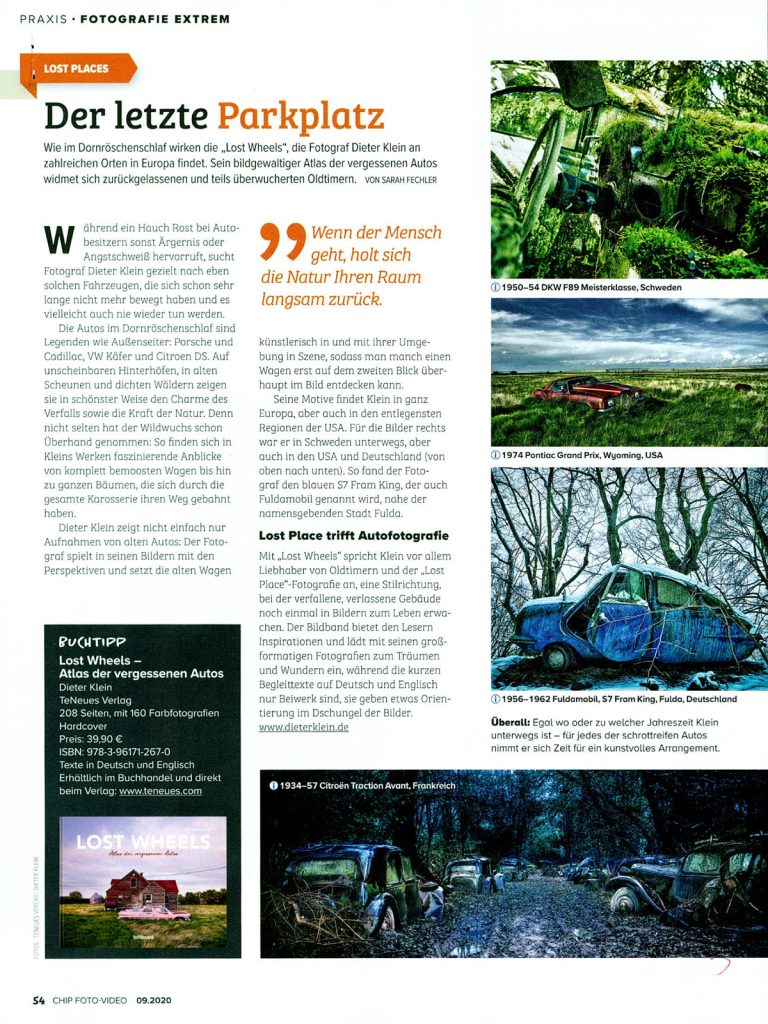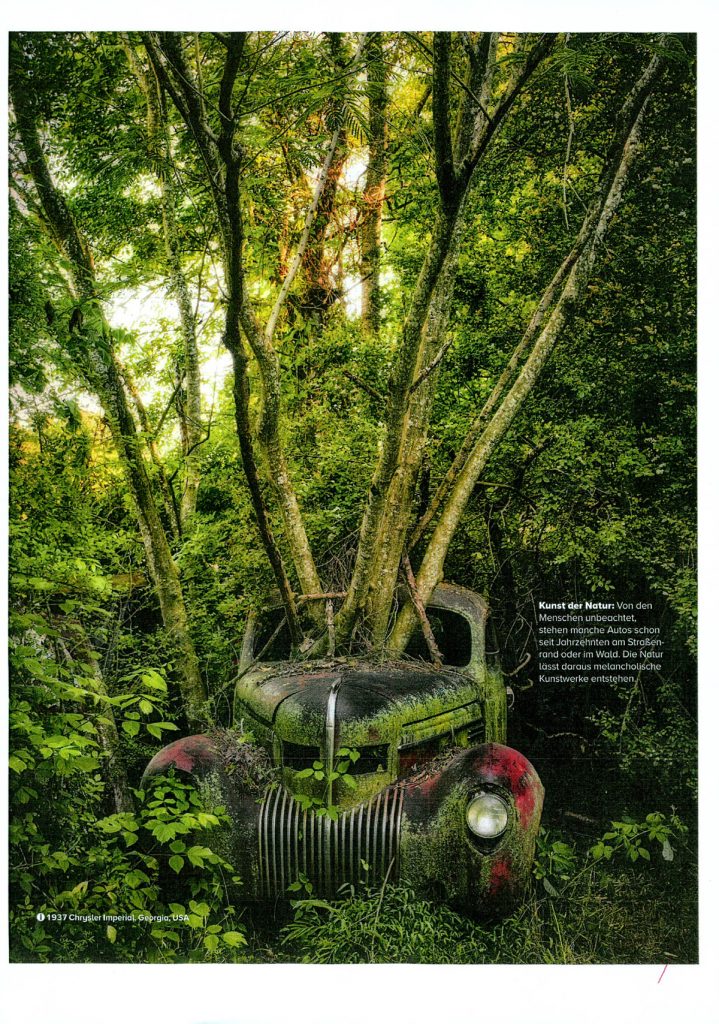
Der letzte Parkplatz
Wie im Dornröschenschlaf wirken die „Lost Wheels“, die Fotograf Dieter Klein an
zahlreichen Orten in Europa findet. Sein bildgewaltiger Atlas der vergessenen Autos
widmet sich zurückgelassenen und teils überwucherten Oldtimern.
von SARAH FECHLER
Während ein Hauch Rost bei Autobesitzern sonst Ärgernis oder Angstschweiß hervorruft, sucht Fotograf Dieter Klein gezielt nach eben solchen Fahrzeugen, die sich schon sehr lange nicht mehr bewegt haben und es vielleicht auch nie wieder tun werden.
Die Autos im Dornröschenschlaf sind Legenden wie Außenseiter: Porsche und Cadillac, VW Käfer und Citroen DS. Auf unscheinbaren Hinterhöfen, in alten Scheunen und dichten Wäldern zeigen sie in schönster Weise den Charme des Verfalls sowie die Kraft der Natur. Denn nicht selten hat der Wildwuchs schon Überhand genommen: So finden sich in Kleins Werken faszinierende Anblicke von komplett bemoosten Wagenbis hin zu ganzen Bäumen, die sich durch die gesamte Karosserie ihren Weg gebahnt haben.
Wenn der Mensch geht, holt sich die Natur Ihren Raum langsam zurück.
Dieter Klein zeigt nicht einfach nur Aufnahmen von alten Autos: Der Fotograf spielt in seinen Bildern mit den Perspektiven und setzt die alten Wagen künstlerisch in und mit ihrer Umgebung in Szene, sodass man manch einen Wagen erst auf dem zweiten Blick überhaupt im Bild entdecken kann. Seine Motive findet Klein in ganz Europa, aber auchin den entlegensten Regionen der USA. Für die Bilder rechts war er in Schweden unterwegs, aber auch in den USA und Deutschland (von oben nach unten). So fand der Fotograf den blauen 57 Fram King, der auch Fuldamobil genannt wird, nahe der namensgebenden Stadt Fulda.
Lost Place trifft Autofotografie
Mit „Lost Wheels“ spricht Klein vor allem Liebhaber von Oldtimern undder „Lost Place“-Fotografie an, eine Stilrichtung, bei der verfallene, verlassene Gebäude noch einmal in Bildern zum Leben erwachen. Der Bildband bietet den Lesern Inspirationen und lädt mit seinen großformatigen Fotografien zum Träumen und Wundern ein, während die kurzen Begleittexte auf Deutsch und Englisch nur Beiwerk sind, sie geben etwas Orientierung im Dschungel der Bilder.
www.dieterklein.de

The last parking lot
The „Lost Wheels“ that photographer Dieter Klein finds in numerous places in
numerous places in Europe. His visually stunning atlas of forgotten cars
is dedicated to abandoned and partly overgrown classic cars.
by SARAH FECHLER
While a hint of rust usually evokes annoyance or sweat of fear in car owners, photographer Dieter Klein specifically searches for just such vehicles that have not moved for a very long time and may never do so again.
The cars in slumber are legends as well as outsiders: Porsche and Cadillac, VW Beetle and Citroen DS. In inconspicuous backyards, old barns and dense forests, they beautifully display the charm of decay as well as the power of nature. For it is not uncommon for wild growth to have taken over: Thus, fascinating sights of completely mossy carsto entire trees that have made their way through the entire body can be found in Klein’s works.
When man leaves, nature slowly reclaims its space.
Dieter Klein doesn’t just show pictures of old cars: the photographer plays with perspectives in his pictures and artistically stages the old cars in and with their surroundings, so that some cars can only be discovered in the picture at second glance. Klein finds his motifs all over Europe, but also in the remotest regions of the USA. For the pictures on the right, he was on the road in Sweden, but also in the USA and Germany (from top to bottom). That’s how the photographer found the blue 57 Fram King, also known as the Fuldamobil, near the city of Fulda, which gives it its name.
Lost Place Meets Car Photography
With „Lost Wheels,“ Klein primarily appeals to lovers of classic cars and „lost place“ photography, a style in which dilapidated, abandoned buildings once again come to life in pictures. The illustrated book offers readers inspiration and, with its large-format photographs, invites them to dream and wonder, while the brief accompanying texts in German and English are merely incidental; they provide some orientation in the jungle of images.
www.dieterklein.de
